What Is Self-Monitoring In Reading: A Comprehensive Guide
Reading Comprehension: Monitoring
Keywords searched by users: What is self monitoring in reading self-monitoring reading activities, self-monitoring reading comprehension checklist, self-monitoring activities for students, self-monitoring skills examples, self-monitoring strategies for adults, self-monitoring strategies for behavior, self-monitoring tools for students, self-correct when reading lesson plan
What Does Self-Monitor Mean In Reading?
What does “self-monitoring” mean in the context of reading? Self-monitoring is a crucial indicator that a student is transitioning into an engaged and proactive learner. When individuals engage in self-monitoring while reading, they actively pay attention to their own reading process. This involves listening to their own voice as they read and constantly assessing their comprehension. By doing so, readers can identify discrepancies or inconsistencies in their understanding of the text. Essentially, self-monitoring in reading requires individuals to be introspective about their reading experience, ensuring that they are comprehending the material effectively. This active approach to reading enhances one’s ability to learn and retain information from the text.
What Is Self-Monitoring Examples?
Self-monitoring examples refer to the practice of tracking and assessing one’s behavior or actions in various contexts, such as work or daily life, to achieve specific goals or improve performance. For instance, in a work setting, an illustration of self-monitoring involves utilizing a checklist as a tool to maintain concentration on essential tasks. By consistently using the checklist and paying attention to how frequently distractions from non-work-related activities occur, individuals can gain valuable insights into their productivity and work habits. This self-monitoring technique not only helps individuals stay on track but also enables them to make informed adjustments to enhance their efficiency and time management skills.
What Is The Goal Of Self-Monitoring Reading?
Self-monitoring reading is a set of strategies designed to empower students to actively track their comprehension and grasp of the content when engaged in the process of reading intricate texts. These strategies not only facilitate students in monitoring their own reading progress but also serve several other key purposes:
-
Enhancing Independence: Self-monitoring reading strategies empower students to become more self-reliant learners. By equipping them with tools to gauge their comprehension, students can navigate challenging texts with greater autonomy.
-
Deepening Textual Understanding: Another pivotal outcome of employing self-monitoring strategies is the cultivation of a more profound understanding of the material being read. By pausing to assess their comprehension, students can identify areas where they may need to delve deeper, thereby promoting a more comprehensive grasp of the text.
-
Identifying Areas of Improvement: Self-monitoring reading strategies also enable students to pinpoint specific areas where they may need to improve their reading skills. This insight can guide them in seeking additional support or adopting targeted techniques to strengthen their reading comprehension abilities.
In summary, self-monitoring reading strategies play a vital role in fostering independence, enhancing comprehension, and aiding students in their quest for effective reading skills, ultimately contributing to more successful learning experiences.
Discover 12 What is self monitoring in reading



Categories: Aggregate 33 What Is Self Monitoring In Reading
See more here: c1.chewathai27.com

Self-monitoring comprehension during reading means attending to whether the reading is making sense and using strategies to fix up any mixups. The ability to self-monitor may well be the biggest distinction between effective and ineffective readers.Self-monitoring is a clear sign that a student is becoming an active learner. Readers must listen to themselves as they are reading in order to notice mismatches and to notice whether or not they are understanding what they are reading.An example of self-monitoring at work could include using a checklist to stay focused on the tasks you need to complete and observing how often you get off task with non-work related activities.
Learn more about the topic What is self monitoring in reading.
- Self-Monitoring Comprehension – HIP Books
- Don’t Teach Strategies: Self-monitoring & Cross-checking …
- Self-Monitoring
- How Self-monitoring Strategies Support Students When …
- What Is Comprehension Monitoring? (Explained for Beginners)
- Teach Students to Change Behaviors Through Self-Monitoring
See more: c1.chewathai27.com/category/money-policy